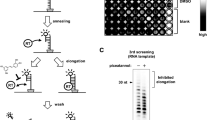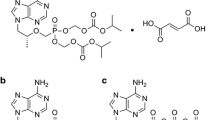Abstract
Hepatitis B virus (HBV), a typical member of the Hepadnaviridae family, is responsible for infections that cause B-type hepatitis which leads to severe public health problems around the world. The small enveloped DNA-containing virus replicates via reverse transcription, and this unique process is accomplished by the virally encoded reverse transcriptase (RT). This multi-functional protein plays a vital role in the viral life cycle. Here, we provide a summary of current knowledge regarding the structural characteristics and molecular mechanisms of HBV RT. Improved understanding of these processes is of both theoretical and practical significance for fundamental studies of HBV and drug discovery.
Similar content being viewed by others
References
Bartenschlager R, Schaller H. 1992. Hepadnaviral assembly is initiated by polymerase binding to the encapsidation signal in the viral RNA genome. EMBO J, 11(9): 3413–3420.
Beck J, Nassal M. 1997. Sequence- and structure-specific determinants in the interaction between the RNA encapsidation signal and reverse transcriptase of avian hepatitis B viruses. J Virol, 71(7): 4971–4980.
Beck J, Nassal M. 1998. Formation of a functional hepatitis B virus replication initiation complex involves a major structural alteration in the RNA template. Mol Cell Biol, 18(11): 6265–6272.
Beck J, Nassal M. 2003. Efficient Hsp90-independent in vitro activation by Hsc70 and Hsp40 of duck Hepatitis B virus reverse transcriptase, an assumed Hsp90 client protein. J Biol Chem, 278(38): 36128–36138.
Beck J, Nassal M. 2007. Hepatitis B virus replication. World J Gastroenterol, 13(1): 48–64.
Beck J, Vogel M, Nassal M. 2002. dNTP versus NTP discrimination by phenylalanine 451 in duck hepatitis B virus P protein indicates a common structure of the dNTP-binding pocket with other reverse transcriptases. Nucl Acids Res, 30(7): 1679–1687.
Chen Y, Marion P L. 1996. Amino acids essential for RNase H activity of hepadnaviruses are also required for efficient elongation of minus-strand viral DNA. J Virol, 70(9): 6151–6156.
Chen Y, Robinson W S, Marion P L. 1994. Selected mutations of the duck hepatitis B virus P gene RNase H domain affect both RNA packaging and priming of minusstrand DNA synthesis. J Virol, 68(8): 5232–5238.
Feng H, Hu K. 2008. Aptamers against viral hepatitis: from rational design to practical application. Virol Sin, 23(5): 315–320.
Gao W, Hu J. 2007. Formation of Hepatitis B Virus Covalently Closed Circular DNA: Removal of Genome- Linked Protein. J Virol, 81(12): 6164–6174.
Girard F C, Ottink O M, Ampt K A. et al. 2007. Thermodynamics and NMR studies on Duck, Heron and Human HBV encapsidation signals. Nucl Acids Res, 35(8): 2800–2811.
Habig J W, Loeb D D. 2006. Sequence identity of the direct repeats, DR1 and DR2, contributes to the discrimination between primer translocation and in situ priming during replication of the duck hepatitis B virus. J Mol Biol, 364(1): 32–43.
Haines K M, Loeb D D. 2007. The sequence of the RNA primer and the DNA template influence the initiation of plus-strand DNA synthesis in hepatitis B virus. J Mol Biol, 370(3): 471–480.
Hu J, Boyer M. 2006. Hepatitis B virus reverse transcriptase and ε RNA sequences required for specific interaction in vitro. J Virol, 80(5): 2141–2150.
Hu J, Flores D, Toft D, et al. 2004. Requirement of heat shock protein 90 for human hepatitis B virus reverse transcriptase function. J Virol, 78(23): 13122–13131.
Hu J, Lin L. 2009. RNA-protein interactions in hepadnavirus reverse transcription. Front Biosci, 14: 1606–1618.
Hu J, Nguyen D. 2004. Therapy for chronic hepatitis B: the earlier, the better? Trends Microbiol, 12(10): 431–433.
Hu J, Seeger C. 1996. Hsp90 is required for the activity of a hepatitis B virus reverse transcriptase. Proc Natl Acad Sci USA, 93(3): 1060–1064.
Hu J, Toft D, Anselmo D, et al. 2002. In vitro reconstitution of functional Hepadnavirus reverse transcriptase with cellular chaperone proteins. J Virol, 76(1): 269–279.
Hu J, Toft D, Seeger C. 1997. Hepadnavirus assembly and reverse transcription require a multi-component chaperone complex which is incorporated into nucleocapsids. EMBO J, 16(1): 59–68.
Hu K, Beck J, Nassal M. 2004. SELEX-derived aptamers of the duck hepatitis B virus RNA encapsidation signal distinguish critical and non-critical residues for productive initiation of rever transcription. Nucl Acids Res, 32(14): 4377–4389.
Huang H, Chopra R, Verdine G L, et al. 1998. Structure of a covalently trapped catalytic complex of HIV-1 reverse transcriptase: implications for drug resistance. Science, 282(5394): 1669–1675.
Joyce C M. 1997. Choosing the right sugar: how polymerases select a nucleotide substrate. Proc Natl Acad Sci USA, 94(5): 1619–1622.
Kim H Y, Kim H Y, Jung J, et al. 2008. Incorporation of deoxyribonucleotides and ribonucleotides by a dNTP-binding cleft mutated reverse transcriptase in hepatitis B virus core particles. Virology, 370(1): 205–212.
Lanford R E, Notvall L, Lee H, et al. 1997. Transcomplementation of nucleotide priming and reverse transcription between independently expressed TP and RT domains of the hepatitis B virus reverse transcriptase. J Virol, 71: 2996–3004.
Lin L, Hu J. 2008. Inhibition of hepadnavirus reverse transcriptase-epsilon RNA interaction by porphyrin compounds. J Virol, 82(5): 2305–2312.
Lin X, Ma Z M, Yao X, et al. 2005. Substitution of proline 306 in the reverse transcriptase domain of hepatitis B virus regulates replication. J Gen Virol, 86(1): 85–90.
Lin X, Yuan Z H, Wu L, et al. 2001. A single amino acid in the reverse transcriptase domain of hepatitis B virus affects virus replication efficiency. J Virol, 75(23): 11827–11833.
Liu N, Ji L, Maguire M L, et al. 2004. cis-Acting sequences that contribute to the synthesis of relaxedcircular DNA of human hepatitis B virus. J Virol, 78(2): 642–649.
Nassal M. 2008. Hepatitis B viruses: Reverse transcription a different way. Virus Research, 134(1–2): 235–249.
Nassal M, Rieger A. 1996. A bulged region of the hepatitis B virus RNA encapsidation signal contains the replication origin for discontinuous firststrand DNA synthesis. J Virol, 70(5): 2764–2773.
Nassal M, Schaller H. 1994. Hepatitis B virus replication. Trends Microbiol, 1(6): 221–228.
Ono S K, Kato N, Shiratori Y, et al. 2001. The polymerase L528M mutation cooperates with nucleotide binding-site mutations, increasing hepatitis B virus replication and drug resistance. J Clin Invest, 107(4): 449–455.
Potenza N, Salvatore V, Raimondo D, et al. 2007. Optimized expression from a synthetic gene of an untagged RNase H domain of human hepatitis B virus polymerase which is enzymatically active. Protein Expr Purif, 55(1): 93–99.
Radziwill G, Tucker W, Schaller H. 1990. Mutational analysis of the hepatitis B virus P gene product: domain structure and RNase H activity. J Virol, 64(2): 613–620.
Schaaf S G, Beck J, Nassal M. 1999. A small 2′-OH- and base-dependent recognition element downstream of the initiation site in the RNA encapsidation signal is essential for hepatitis B virus replication initiation. J Biol Chem, 274(53): 37787–37794.
Seeger C, Mason W S. 2000. Hepatitis B virus biology. Microbiol Mol Biol Rev, 64(1): 51–68.
Stahl M, Beck J, Nassal M. 2007. Chaperones Activate Hepadnavirus Reverse Transcriptase by Transiently Exposing a C-Proximal Region in the Terminal Protein Domain That Contributes to ε RNA Binding. J Virol, 81(24): 13354–13364.
Stahl M, Retzlaff M, Nassal M, et al. 2007. Chaperone activation of the hepadnaviral reverse transcriptase for template RNA binding is established by the Hsp70 and stimulated by the Hsp90 system. Nucleic Acids Research, 35(18): 6124–6136.
Summers J, Mason W S. 1982. Replication of the genome of a hepatitis B-like virus by reverse transcription of an RNA intermediate. Cell, 29(2): 403–415.
Van Hemert F J, Zaaijer H L, Berkhout B, et al. 2008. Mosaic amino acid conservation in 3D-structures of surface protein and polymerase of hepatitis B virus. Virology, 370(2): 362–372.
Wang G H, Seeger C. 1992. The reverse transcriptase of hepatitis B virus acts as a protein primer for viral DNA synthesis. Cell, 71(4): 663–670.
Wang G H, Seeger C. 1993. Novel mechanism for reverse transcription in hepatitis B viruses. J Virol, 67(11): 6507–6512.
Wang X, Qian X, Guo H C, et al. 2003. Heat shock protein 90-independent activation of truncated Hepadnavirus reverse transcriptase. J Virol, 77(8): 4471–4480.
Ying C, Li Y, Leung C H, et al. 2007. Unique antiviral mechanism discovered in anti-hepatitis B virus research with a natural product analogue. Proc Natl Acad Sci USA, 104(20): 8526–8531.
Zoulim F, Seeger C. 1994. Reverse transcription in hepatitis B viruses is primed by a tyrosine residue of the polymerase. J Virol, 68(1): 6–13.
Author information
Authors and Affiliations
Corresponding author
Additional information
Foundation items: National Nature Science Foundations of China (30870131) and Program of Chinese Academy of Sciences (0802021SA1).
Rights and permissions
About this article
Cite this article
Feng, H., Hu, Kh. Structural characteristics and molecular mechanism of hepatitis B virus reverse transcriptase. Virol. Sin. 24, 509–517 (2009). https://doi.org/10.1007/s12250-009-3076-6
Received:
Accepted:
Published:
Issue Date:
DOI: https://doi.org/10.1007/s12250-009-3076-6




